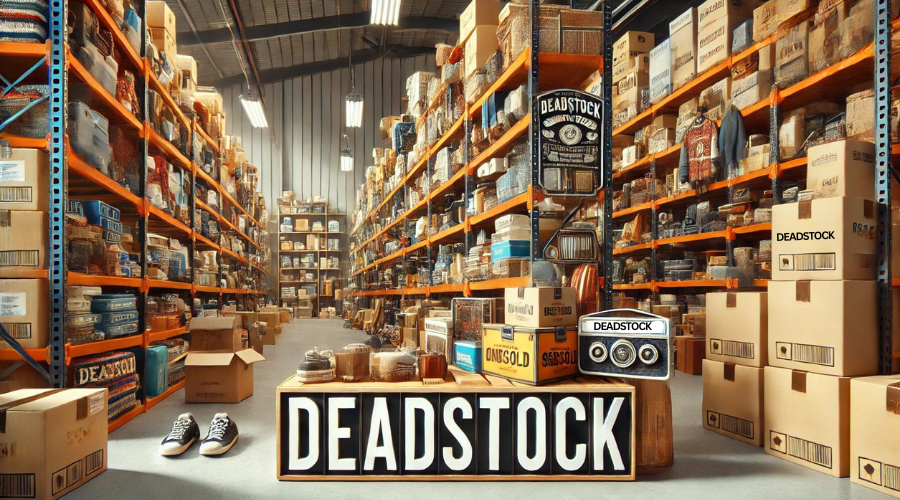Table of Contents
Introduction
Managing inventory effectively is crucial for any business. One significant challenge many face is dealing with deadstock. But what is deadstock? Why is it a concern, and how can businesses manage or prevent it? This comprehensive guide will provide insights into these questions, helping you understand and address deadstock in your inventory.What Does Deadstock Mean?
Deadstock refers to inventory that doesn’t sell and remains unsold for an extended period. For businesses lacking inventory management systems, deadstock can accumulate unnoticed, taking up valuable warehouse space. These unsold items often include out-of-season clothing, outdated electronics, or excess inventory from overproduction, tying up capital and resources.Causes of Deadstock
Understanding the causes of deadstock can help businesses take proactive measures to avoid it. Here are some common reasons:- Overproduction: Producing more than needed leads to excess inventory. This often happens when businesses miscalculate market demand or fail to adjust production rates based on sales data. Overproduction can result in a significant amount of inventory that never reaches the customer, leading to waste and financial loss.
- Poor Sales Forecasting: Inaccurate demand predictions result in surplus stock. When businesses rely on flawed data or fail to account for market trends and consumer behavior, they may end up ordering or producing too much inventory. This miscalculation can lead to an excess of products that customers aren’t interested in buying.
- Seasonal Demand Fluctuations: Products only in demand during specific seasons can become deadstock after the season ends. For example, holiday decorations, winter clothing, or summer accessories may see a spike in sales during certain times of the year. Once the season passes, these items may no longer be desired, leading to leftover stock.
- Changes in Market Trends and Consumer Preferences: Rapid shifts in trends can render certain products obsolete. Consumer preferences can change quickly, especially in fast-paced industries like fashion and technology. A product that was popular last year might not be in demand this year, leaving businesses with unsellable inventory.
The Negative Impacts of Deadstock on Retail Businesses
- Capital Investment: Deadstock represents a significant capital investment that isn’t generating returns. Money tied up in unsold inventory could be better utilized elsewhere in the business, such as in marketing, new products, or expansion efforts.
- Storage Costs: Storing unsold products incurs costs, whether in a warehouse, retail store, or other facilities. Deadstock occupies space that could be used for inventory that sells well, leading to inefficiency and additional expenses.
- Depreciation and Obsolescence: Products lose value over time, particularly trendy or seasonal items, and tech products that quickly become outdated. The longer items remain unsold, the more their value diminishes, making it harder to sell them at a profitable price.
- Risk of Damage or Expiry: Unsold inventory is at risk of damage, becoming obsolete, or expiring, especially if it has a limited shelf life. This further devalues the stock and increases the likelihood of financial loss.
- Opportunity Cost: Deadstock ties up resources that could be invested in high-demand inventory. The potential revenue from better-performing stock is lost, negatively affecting the business’s bottom line.
- Negative Impact on Cash Flow:Deadstock can severely impact cash flow, reducing the capital available for other critical business areas, such as operations, expansion, or marketing efforts. This cash flow issue can stifle growth and hinder the overall financial health of the business.
- Impacts Business Analytics: Excess inventory skews business analytics, making it difficult to accurately assess inventory turnover rates and sales forecasting. This can lead to poor strategic planning and perpetuate a cycle of overestimating demand, resulting in more deadstock.
Solutions for Managing Deadstock
Once deadstock is identified, businesses can employ several strategies to manage it:- Discount Sales and Clearance Events: Offering discounts can help move unsold inventory. Hosting clearance events can attract customers looking for bargains, helping to clear out old stock.
- Donation and Recycling Options: Donating or recycling unsold goods can provide tax benefits and reduce environmental impact. This can also enhance the company’s image as socially responsible.
- Bundling Products: Combining slow-moving items with popular ones can increase sales. Bundling can create perceived value for customers and help move deadstock.
- Improved Forecasting and Inventory Management: Using data analytics to predict demand more accurately can prevent overstocking. Implementing robust inventory management systems can help keep track of stock levels and prevent excess inventory.
- Returns to Suppliers: If possible, returning unsold goods to suppliers can be a viable option. Some suppliers may accept returns or exchanges, reducing the burden of deadstock.
- Repurposing Inventory: Finding alternative uses for deadstock or repurposing it into new products can help recover some value from unsold items.
Preventing Deadstock
Prevention is better than cure. Here are some strategies to prevent deadstock:- Effective Inventory Management Strategies: Implementing just-in-time inventory and maintaining optimal stock levels can help. Just-in-time inventory practices minimize excess inventory by ordering goods only when needed.
- Data Analysis and Sales Forecasting: Utilizing historical sales data and market trends can improve forecasting accuracy. This helps in making informed decisions about inventory levels and production quantities.
- Just-in-Time Inventory Practices: This approach minimizes excess inventory by ordering goods only when needed. It reduces the risk of overproduction and helps maintain lean inventory.
- Diversifying Product Lines: Offering a variety of products reduces the risk of any single item becoming deadstock. Diversification can also attract a broader customer base and increase sales.
How to Find Deadstock Stores?
To find deadstock stores, you can explore the following avenues:- Online Marketplaces: Platforms like eBay and Amazon often have sections for overstock and liquidation items. Specialized websites like Liquidation.com and B-Stock Solutions cater specifically to deadstock and excess inventory, offering a variety of products at discounted prices.
- Retail Outlets: Outlet malls and discount stores are excellent places to find deadstock. Stores like T.J.Maxx, Ross, and Nordstrom Rack specialize in selling overstock and unsold inventory from major brands at reduced prices.
- Wholesale Liquidators: Companies like Direct Liquidation and Liquidation.com purchase excess inventory from businesses and resell it in bulk. These wholesale liquidators often have physical warehouses and online platforms where you can browse their offerings.
- Business Directories: Utilize online business directories such as Yelp, Yellow Pages, or local chamber of commerce websites to find deadstock stores in your area. Searching for terms like “liquidation store” or “overstock retailer” can yield helpful results.
- Networking: Industry contacts, suppliers, and business associations can provide valuable recommendations. Attend trade shows, business expos, and networking events to connect with others who might know where to find deadstock stores.
- Search Engines: Use search engines like Google to find online deadstock retailers. Search for terms such as “deadstock stores,” “liquidation sales,” or “excess inventory retailers.” This can lead you to specialized websites and local store listings.
Example Scenario
Imagine you’re looking to buy deadstock electronics. Start by checking eBay and Amazon for liquidation deals. Visit local outlet malls to see if they have any unsold tech items. Search online for wholesale liquidators that deal in electronics. Use business directories to find nearby liquidation stores. Network with industry peers who might have leads. Finally, search Google for “deadstock electronics stores” to explore more options. By exploring these avenues, you can find deadstock stores that offer a wide range of products at discounted prices, helping you save money while sourcing inventory.Case Studies
To provide a practical understanding, let’s look at some case studies of businesses that successfully managed their deadstock:- Case Study 1: Fashion RetailerA fashion retailer faced significant deadstock issues due to seasonal demand fluctuations. By implementing better forecasting tools and conducting end-of-season sales, they managed to reduce their deadstock by 30% in one year.
- Case Study 2: Electronics Store An electronics store struggled with deadstock due to rapid changes in technology. They started bundling outdated products with newer models and offered significant discounts. This strategy helped them clear out old inventory and make space for new stock.



 Integrated Supplier Network
Integrated Supplier Network



